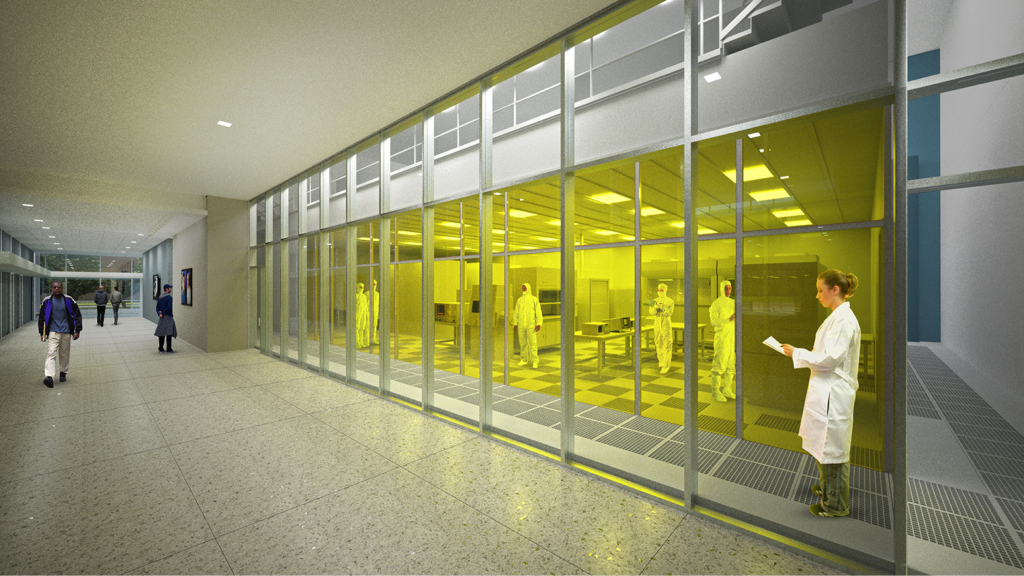Building Campaign Navigation

Recent Posts
- ECE ILLINOIS dedicates two sculptures at new building
- ECE Building includes state-of-the-art music lab
- Donor wall celebrates leadership donors to the Building Campaign for ECE ILLINOIS
- Robotics Laboratory prepares students for the future
- A revamped Digital Signals Lab
- ECE Building grounds’ history with Illinois
- Generating improved power labs
- Low donation funds classroom wing
- Introducing the Open Projects Lab
- $1 million gift makes Srivastava Senior Design Lab possible
THE BUILDING CAMPAIGN FOR ECE ILLINOIS
Intel donation to provide undergrads a chance to work in groundbreaking nanofabrication lab
Nanofabrication is a popular concept in the tech industry right now, but the typical undergraduate student doesn’t have a chance to try it.
That’s about to change at ECE ILLINOIS.
Intel is donating three pieces of equipment that will form the basis of a lab space that will allow undergraduates to learn about the concept. It will be located in the new ECE Building’s nanofabrication laboratory.
“For students, using this equipment will expose them to research-level processes that most students never have the opportunity to explore until graduate school,” said Dane Joseph Sievers, an engineering teaching lab specialist at ECE.
The lab and its equipment will expand graduating students’ knowledge, and expose them to new and emerging processes and technologies that, until now, haven’t been available in any undergraduate lab Sievers knows about.
Intel Senior Fellow and ECE alumnus Mark Bohr (MSEE ’78) said Illinois has been a leader among academic institutions as it offers a microfabrication laboratory course for its undergraduates.
“This course gives students hands-on training and experience in some of the fabrication techniques used by integrated circuit companies like Intel to make microprocessor chips,” he said. “With an eye to the future, this new laboratory course for undergraduate students teaches nanofabrication techniques using dimensions about 1,000 times smaller than in the previous course.”
“Intel is a strong supporter of engineering education and believes that this new nanofabrication course will both prepare and interest students in some of the engineering challenges we’ll face over the next 40 years,” Bohr said. “I’m very pleased that Intel had the opportunity to play a part in setting up this new nanofabrication class.”
Burke Walls, a global college talent strategist within Intel’s College Center of Excellence, said the new building prominently features the importance of undergraduate education.
“Student interns and new college graduates face challenges here, and nothing has been done in school to prepare them,” he said. “The donation will go a long way. They can say, ‘I’ve done this, I’ve done similar things and it’s time to get ramped up on something new.’”
The equipment will be used in the prominently featured lab space on the first floor of the new building, where windows will reveal students fabricating colloidal quantum dots, nanowires, non-ring oscillators, and carbon nanotube LEDs, using optoelectronics and plasmonics, on novel materials, like carbon nanotubes or grapheme, rather than just silicon.
The equipment includes a dual-beam focused ion beam, which is “like multiple tools in one,” because it has both an ion beam and an electron beam, Sievers said, and can be used for imaging, lithography, etching, and depositing materials.
Another donated piece of equipment will be a sputtering tool that allows students to deposit multiple types of materials that make up the different parts of the devices they’re fabricating. It offers the advantage of uniform coatings with different types of materials, Sievers said.
The third piece of equipment, a tool for di-electric deposition, will allow students to use plasma to deposit a variety of materials at much lower temperatures than using other methods. This will give them the flexibility to add new layers of materials without destroying underlying features.
ECE Professor Joseph W. Lyding said the lab will be “one of the most advanced teaching facilities ever devoted to undergraduate education.”
“The nanofabrication teaching laboratory will give our students a unique immersive perspective on how nanotechnology is changing our modern world,” he said.
For more information, please see the full story on the ECE ILLINOIS website.



